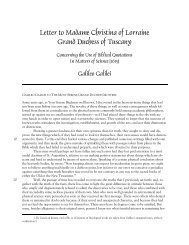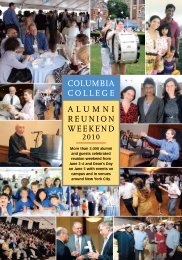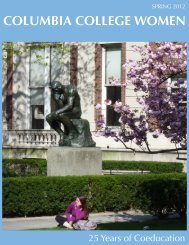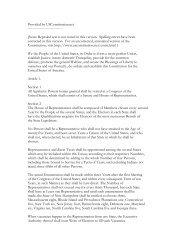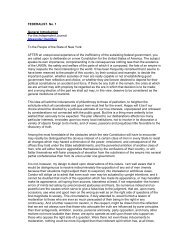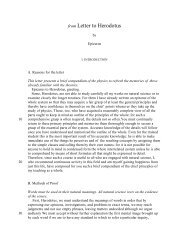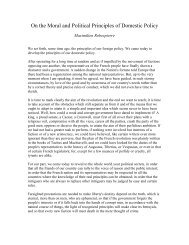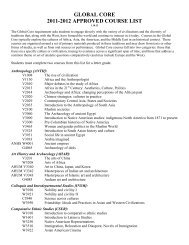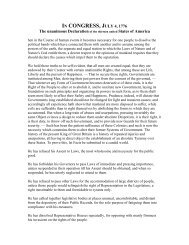Japan Storm - Columbia College - Columbia University
Japan Storm - Columbia College - Columbia University
Japan Storm - Columbia College - Columbia University
Create successful ePaper yourself
Turn your PDF publications into a flip-book with our unique Google optimized e-Paper software.
JAPAN AFTER THE STORM COLUMBIA COLLEGE TODAY<br />
eral times, Hayes says, not reporting elevated radiation in certain<br />
areas and in the food supply. “They released information late —<br />
there was a lot of fumbling around,” she says. “There was an aura<br />
of calm, but news stories popped up that upset people.” She cites<br />
the example of the announcement that school lunches contained<br />
potentially radioactive produce from Fukushima; an ensuing argument<br />
that the country needed to support the people and farms<br />
of that region; and a rebuttal that that couldn’t involve endangering<br />
the health of the nation’s children.<br />
Unusual for <strong>Japan</strong>, anti-nuclear energy protests were held<br />
nearly every weekend in Tokyo. “Before, I didn’t even think<br />
about how electricity was produced — I assumed <strong>Japan</strong> was very<br />
environmentally conscious,” Hayes says. “Only afterward did<br />
we find out how vulnerable the country was.”<br />
Hayes’ interest in <strong>Japan</strong> stems from a two-week visit when<br />
she was in high school and stayed with a host family in<br />
Fukuoka, the sister city of her hometown of Atlanta. Entranced<br />
by the country’s history and its pop culture exports, she<br />
knew she wanted to learn <strong>Japan</strong>ese and live there after college.<br />
She was drawn to <strong>Columbia</strong> by its stellar East Asian studies<br />
program and the legacy of scholars such as Ivan Morris and Edward<br />
Seidensticker ’47 GSAS. She started taking <strong>Japan</strong>ese language<br />
classes her first year and became active in the <strong>Japan</strong> Club<br />
(now the <strong>Columbia</strong> <strong>Japan</strong> Society), of which she became v.p. in<br />
her senior year. “It was awesome to be in a city with <strong>Japan</strong>ese<br />
speakers and <strong>Japan</strong>ese cultural events I could attend regularly,”<br />
Hayes says. She adds that there also were plenty of <strong>Japan</strong>-related<br />
events on campus, such as the annual spring Matsuri festival<br />
on Low Plaza, with its noodle-eating contest, mock wrestling in<br />
inflatable sumo suits and thunderous taiko drum performances.<br />
For her junior year abroad, Hayes studied in a yearlong program<br />
run by the Kyoto Consortium for <strong>Japan</strong>ese Studies and<br />
lived with a local host family.<br />
Following graduation, she joined the <strong>Japan</strong>ese Exchange and<br />
Teaching (JET) program, which places recent college graduates<br />
from around the world in schools or government offices. Hayes<br />
was posted as coordinator of international relations at Nagano<br />
City Hall.<br />
In that job, she acted as an interpreter for local foreign residents<br />
who didn’t speak <strong>Japan</strong>ese, helped plan cross-cultural<br />
events and arranged visits for Americans from Nagano’s sister<br />
city of Clearwater, Fla. She wrote an essay on the importance of<br />
international exchange that won her a local contest to run with<br />
the Olympic torch when it passed through Nagano in 2008 on its<br />
way to the summer games in Beijing. (Many people asked her,<br />
“Are you training?” “You walk briskly and wave,” she says. “It<br />
wasn’t a marathon or anything.”)<br />
“She’s about as smart as they come. When we met, I was pretty<br />
blown away by her <strong>Japan</strong>ese ability,” says Grant Peterson, a<br />
fellow American working in Nagano. “Then after seeing her belt<br />
out a beautiful song at a mutual friend’s wedding, and seeing her<br />
perform a dance routine at an international event, I was amazed<br />
to keep finding all of these hidden talents Ashley possessed.”<br />
Hayes was a karaoke singer, “then when I went to <strong>Japan</strong>, all of a<br />
sudden people started asking me to sing for real!” she says. “I’ve<br />
actually sung at three weddings now courtesy of my karaoke<br />
performances — and I’ve also danced in public when asked to.<br />
I guess I don’t like to let people down. If someone asks me to do<br />
something, I try to rise to the occasion.”<br />
In Nagano, Hayes lived in a traditional apartment with tatami<br />
rooms and sliding doors — and no central heating, which the<br />
Southerner never did get used to. Although she initially questioned<br />
whether Nagano, a city of 381,000 in a largely agrarian<br />
region, was exciting enough for someone who grew up in East<br />
Atlanta and went to college in New York, Hayes came to love<br />
apple-picking, riding her bicycle around town and appreciating<br />
locally grown food. “Almost everyone had a rice paddy or a vegetable<br />
garden,” she says. “It wasn’t just Old MacDonald on the<br />
farm, it was your coworkers.” The <strong>Japan</strong>ese reverence for nature,<br />
she says, gave her a new perspective on rural living.<br />
Entranced by the country’s history and its<br />
pop culture exports, Hayes knew she wanted to learn<br />
<strong>Japan</strong>ese and live there after college.<br />
WINTER 2011–12<br />
36<br />
After four years working in Nagano in the JET program<br />
(which allows renewals up to five years), Hayes decided<br />
to move to Tokyo, which she’d always wanted to<br />
experience. She started work at the translation agency<br />
in summer 2010. While she had thought she craved urban living<br />
again, she says the 9–5 grind left her feeling more like a beleaguered<br />
worker bee: “You get on a very cramped train and work<br />
all day and take the train home. People on the train during rush<br />
hour disregard all concepts of personal space. People think of the<br />
<strong>Japan</strong>ese as very polite and noble, but they also push you and jab<br />
you and step on you.”<br />
Following the chaos and uncertainty of the earthquake and<br />
its aftermath, Hayes eventually decided to return to the United<br />
States. She arrived in Atlanta in August, and is moving to San<br />
Antonio, Texas, to teach high school ESL as part of Teach for<br />
America. To further her own language abilities, she is studying<br />
Chinese and Spanish.<br />
“I loved living in <strong>Japan</strong> and still love <strong>Japan</strong> and would consider<br />
living there again,” she says. She reads <strong>Japan</strong>ese newspapers<br />
and blogs every day, and plans to get a rice cooker to try to<br />
make rice the same as it is in <strong>Japan</strong>. Her boyfriend, who won’t<br />
finish undergraduate studies until 2014, might come to graduate<br />
school here. Hayes adds: “I’d like to be one of these Americans<br />
like Donald Keene [’42, ’49 GSAS; see feature in this issue] who’s<br />
a bridge between <strong>Japan</strong> and America.”<br />
Shira Boss ’93, ’97J, ’98 SIPA is a contributing writer to CCT. Her<br />
most recent feature was a profile of environmental lawyer Michael<br />
Gerrard ’72, in the May/June 2011 issue.




